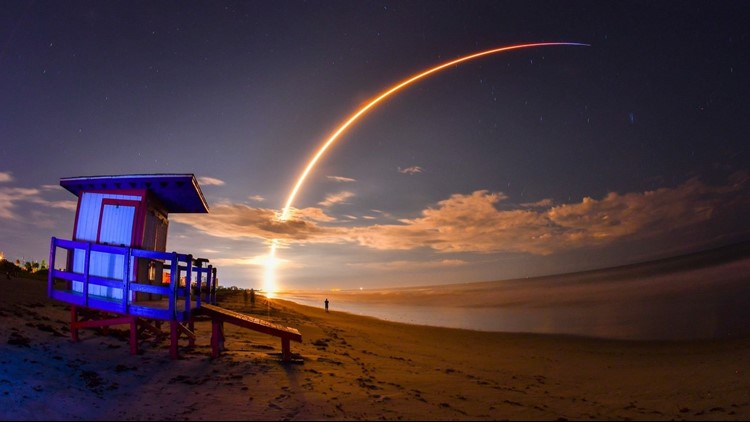SpaceX early Monday completed the second in a pair of successful summer launches for Canadian satellite operator Telesat, the latest example of the company returning commercial launches to Florida.
A new Falcon 9 rocket roared from Cape Canaveral Air Force Station’s Launch Complex 40 at 12:45 a.m., after more than an hour's delay because of rain and lightning.
A trail fire from nine Merlin main engines cut through clouds and darkness on an eastward arc over the Atlantic Ocean, as the rumble from 1.7 million pounds of thrust washed across the Space Coast, awakening some residents.
Thirty-two minutes later, the more than 15,000-pound Telstar 18 Vantage satellite was safely in orbit, on the heels of Telstar 19 Vantage, which was launched July 22 by another Falcon 9.
Less than nine minutes after liftoff, the rocket’s first stage landed 400 miles offshore on the deck of SpaceX’s “Of Course I Still Love You” drone ship — the 29th successful landing by a Falcon booster.
The stage will return to Port Canaveral for inspections and likely be made available for a second launch. SpaceX believes its recently upgraded Falcon 9 should be able to fly 10 or more times with minimal maintenance, which could help cut launch costs further.
Telsesat was once a regular presence at the Cape, launching satellites on Delta rockets and on NASA’s space shuttle in the 1970s and 80s.
But like most commercial satellite firms, the company by the 90s had shifted to lower-cost Russian and European rockets, while American launchers increasingly catered to more expensive U.S. government missions for national security and science.
A commercial launch from the Cape became a rarity by the time Boeing and Lockheed Martin merged their Delta and Atlas fleets under the United Launch Alliance joint venture in 2006.
But Telesat said it welcomed the opportunity to return to Florida, where several hundred employees and customer guests visited over the two missions.
Given the choice, “our customers would rather come to the Cape than go to Kazakhstan, for example,” said Tom Eaton, Telesat’s vice president of international sales.
SpaceX’s Falcon 9 sent Telstar 18 Vantage on its way to an orbit 22,300 miles over the equator, where it will provide broadband services to the Asia-Pacific region, replacing an older spacecraft.
Built by California-based SSL, the satellite is the third “high-throughput” satellite in Telesat’s fleet of now 17 spacecraft in such high orbits, which can provide faster data speeds.
Eaton said the satellite's services would, for example, help link thousands of remote islands in Indonesia, supporting media, schools, first responders and hospitals.
“That capacity is ideally suited for a country like Indonesia to connect its remote communities and bring them together,” he said.
While expanding its capacity in what is known as geostationary orbit, Telesat is one of several companies — including SpaceX — proposing to deploy a mega-constellation of small satellites in low Earth orbit to provide global Internet.
Initial plans call for a constellation of 117 satellites potentially starting service in 2022. SpaceX’s constellation, in contrast, would include more than 4,000 spacecraft.
The launch was SpaceX’s 16th in 2018, and the 10th of those flying a commercial satellite mission. SpaceX is now two shy of last year’s launch total, with more than three months remaining in the year.
The Eastern Range’s next scheduled mission isn’t until Oct. 6, when Northrop Grumman’s air-launched Pegasus rocket is targeting launch of NASA's ICON science mission.
Before that, NASA’s Launch Services Program and United Launch Alliance are preparing for a flight from California this Saturday, Sept. 15, of an Earth climate mission on the final Delta II rocket.



